
Concept explainers
(a)
Interpretation:
The IUPAC name for the structure is to be given.
Concept introduction:
In the
Answer to Problem A.30P
The correct IUPAC name for the structure is
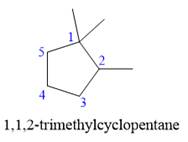
Explanation of Solution
The given structure is
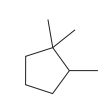
In the structure above, the ring has more carbon atoms than any of the straight chain groups. Hence, the root name of this structure is “cyclopentane.” The carbon atom of this ring, which is attached to two methyl groups, will be numbered as
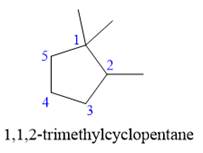
The correct IUPAC name for the given structure is
(b)
Interpretation:
The IUPAC name for the structure is to be given.
Concept introduction:
In the IUPAC nomenclature, the longest continuous carbon chain or the largest carbon ring is considered as the parent chain. The name of this corresponding parent chain/ring will be the root of the molecule’s name. Identify the substituents and add the name of the substituent as a prefix to the left of the root. The number assigned to the carbon that is bonded to the substituent is called the locator number or locant. In case of two or more different substituents, the alphabetical order is considered. Number each carbon atom of the chain sequentially, beginning with
Answer to Problem A.30P
The correct IUPAC name for the structure is
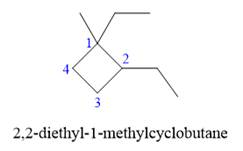
Explanation of Solution
The given structure is

In the above structure, the ring has more carbon atoms than any of the straight chain groups. Hence, the root name of this structure is “cyclobutane.” The carbon atom of this ring, which is attached to two substituents, will be numbered as
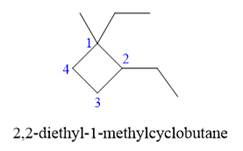
The correct IUPAC name for the given structure is
(c)
Interpretation:
The IUPAC name for the structure is to be given.
Concept introduction:
In the IUPAC nomenclature, the longest continuous carbon chain or the largest carbon ring is considered as the parent chain. The name of this corresponding parent chain/ring will be the root of the molecule’s name. Identify the substituents and add the name of the substituent as a prefix to the left of the root. The number assigned to the carbon that is bonded to the substituent is called the locator number or locant. In case of two or more different substituents, the alphabetical order is considered. Number each carbon atom of the chain sequentially, beginning with
Answer to Problem A.30P
The correct IUPAC name for the structure is
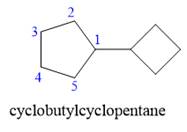
Explanation of Solution
The given structure is

In the structure above, two rings are present. The ring on the left has more number of carbon atoms than the ring on the right; hence the root name of this compound is “cyclopentane.” The carbon atom of this cyclopentane ring to which the cyclobutane ring is attached will be numbered as

The correct IUPAC name for the given structure is
(d)
Interpretation:
The IUPAC name for the structure is to be given.
Concept introduction:
In the IUPAC nomenclature, the longest continuous carbon chain or the largest carbon ring is considered as the parent chain. The name of this corresponding parent chain/ring will be the root of the molecule’s name. Identify the substituents and add the name of the substituent as a prefix to the left of the root. The number assigned to the carbon that is bonded to the substituent is called the locator number or locant. In case of two or more different substituents, the alphabetical order is considered. Number each carbon atom of the chain sequentially, beginning with
Answer to Problem A.30P
The correct IUPAC name for the structure is
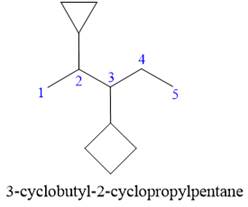
Explanation of Solution
The given structure is
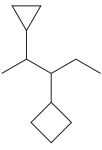
In the structure above, there are two rings and a straight chain of carbon atoms. Out of these, the straight continuous carbon chain has more atoms than any of the rings. Hence, the straight chain carbon will serve as the parent, and the two rings will serve as substituents. Thus, the root name of this structure is “pentane.” The numbering of this parent chain should start from the left as the substituent encountered receives the lowest possible locator number. The two substituents are attached on the
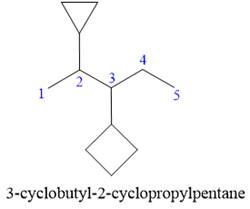
The correct IUPAC name for the given structure is
(e)
Interpretation:
The IUPAC name for the structure is to be given.
Concept introduction:
In the IUPAC nomenclature, the longest continuous carbon chain or the largest carbon ring is considered as the parent chain. The name of this corresponding parent chain/ring will be the root of the molecule’s name. Identify the substituents and add the name of the substituent as a prefix to the left of the root. The number assigned to the carbon that is bonded to the substituent is called the locator number or locant. In case of two or more different substituents, the alphabetical order is considered. Number each carbon atom of the chain sequentially, beginning with
Answer to Problem A.30P
The correct IUPAC name for the structure is
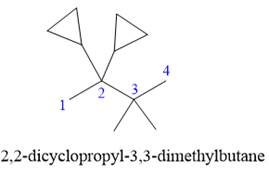
Explanation of Solution
The given structure is
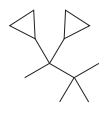
In the structure above, the straight continuous chain of carbon atoms will serve as the parent as it contains the highest number of carbon atoms than the rings. Hence, the root name of this structure is “butane.” There are two types of substituents attached- cyclopropyl and methyl. As the prefix “cyclo” is considered while naming, it will appear first in the IUPAC name. Thus, the numbering will also start from the left so that the carbon atom with two cyclopropyl rings will get the lowest possible locator numbers. The prefix di will be used for both the substituents as they appear twice. Thus, the IUPAC name for this structure is
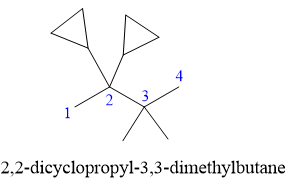
The correct IUPAC name for the given structure is
Want to see more full solutions like this?
Chapter A Solutions
EBK ORGANIC CHEMISTRY: PRINCIPLES AND M
- please provide the structure for this problem, thank youarrow_forwardpresented by Morallen Lig Intermine the hand product for the given mution by adding atoms, bonds, nonhonding diarion panda скуль Step 3: Comp the draw the product Step 2: Agama workup Compithe 429 ملولةarrow_forwardReaction A 0,0arrow_forward
- presented by Morillon Leaning Predict the organic product for the min кусур HSC Adithane carved arnown to come than that to the condon slchroruis in acid in in aquishri with ноюarrow_forward6.15PM Sun Mar 30 K Draw the major product of this reaction. Include any relevant stereochemistry. Ignore inorganic byproducts. Problem 1 of O H [PhзPCH2CH3]*C|¯ NaH Drawing > Q Atoms, Bonds and Draw or tap a nearrow_forward8:17 PM Sun Mar 30 Draw the major product of this reaction. Ignore inorganic byproducts. HSCH2CH2CH2SH, BF3 Probler Drawing Ato Bonds Clarrow_forward
- Name the major organic product of the following action of 4-chloro-4-methyl-1-pentanol in neutral pollution 10+ Now the product. The product has a molecular formula f b. In a singly hain, the starting, material again converts into a secule with the molecular kormula CIO. but with comply Draw the major organic structure inhalationarrow_forwardMacmillan Learning Alcohols can be oxidized by chromic acid derivatives. One such reagent is pyridinium chlorochromate, (C,H,NH*)(CICTO3), commonly known as PCC. Draw the proposed (neutral) intermediate and the organic product in the oxidation of 1-butanol by PCC when carried out in an anhydrous solvent such as CH₂C₁₂. PCC Intermediate OH CH2Cl2 Draw the intermediate. Select Draw Templates More с H Cr о Product Draw the product. Erase Select Draw Templates More H о Erasearrow_forwardIf I have 1-bromopropene, to obtain compound A, I have to add NaOH and another compound. Indicate which compound that would be. A C6H5 CH3arrow_forward
